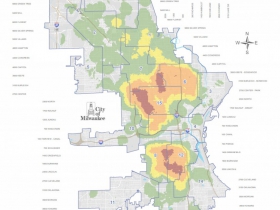Fix Lead Poisoning, Not Lead Pipes
Biden proposes to get rid of lead pipes, but his plan falls far short of tackling lead poisoning.
President Joe Biden‘s $2 trillion infrastructure plan includes $45 billion to replace every lead service line in America.
It’s a laudable moonshot and a great talking point for a politician. But it falls far short of what’s needed to eliminate lead poisoning.
There are two other major problems with the initiative.
One, the service line isn’t the only source of lead in water. Internal plumbing can be made of lead or contain lead solder, a practice banned in 1985. A 2016 study of Milwaukee Public Schools‘ 191 buildings (free of lead service lines) found that six percent of the water fountains emitted lead-contaminated water in excess of the EPA’s 15 parts per billion threshold. The city of Madison replaced all of its lead laterals, but 38% of homes tested still show the presence of lead in the water.
A 2008 study found that as much as 50% of lead in water doesn’t originate with the service line. If you want to get all of the lead out of water, you must replace all of the lead pipes, not just the service line.
Two maps of the city prove the point. The 14th aldermanic district, which includes Bay View and a handful of other southside neighborhoods, has the greatest number of lead service lines. But it has one of the lowest lead poisoning rates among children.
The 15th aldermanic district, particularly the area between W. Center St., W. Juneau Ave., N. 27th St. and N. Sherman Blvd., has fewer lead pipes, but a lead poisoning rate more than four times as high. It is also the city’s most impoverished district.
So what to do? Instead of spending the money solely on replacing lead service lines, cities should be able to spend on any lead remediation. That would allow a city like Milwaukee to pour resources into the most afflicted areas, replacing not just lead service lines, but internal plumbing, and on remediating peeling lead paint. If any amount of lead poisoning is bad, the city should be going after any source of lead poisoning.
Areas like Bay View, where the lead poisoning rate is substantially lower, could be mitigated with a short-term strategy of lead water filters and home inspections for lead hazards. The city could continue its policies of requiring replacement of lead laterals in the event of breaks or nearby water main replacement, while creating an incentive structure for voluntary replacements.
What happens if the whole infrastructure plan fails? The City of Milwaukee will continue to very slowly address the issue. It’s on a 70-year pace to replace its lead service lines. Lead paint abatement isn’t going much faster. The city has abated more than 17,000 properties since 2004, spending $66 million. It received a $5.6 million, 42-month lead paint and soil abatement grant in 2019, estimated to cover 320 homes.
Any house built before 1978, which accounts for most of the houses in the city, is likely to include lead paint. The last lead service line in the city was installed in 1962. The city’s water mains do not contain lead.
Maps
If you think stories like this are important, become a member of Urban Milwaukee and help support real, independent journalism. Plus you get some cool added benefits.
More about the Lead Crisis
- $43 Million Later, MPS Says Classrooms Are Safe From Lead Dust - Corrinne Hess - Dec 18th, 2025
- MPS Buildings Cleared of Lead-Paint Risks after 10-Plus Months of Work - Milwaukee Public Schools - Dec 17th, 2025
- Wisconsin Moves to Require Lead Service Lines Replaced By 2037 - Danielle Kaeding - Dec 11th, 2025
- Gov. Evers, DNR Announce More Than $159 Million to Ensure Clean, Safe Drinking Water for Wisconsinites in 29 Municipalities - Gov. Tony Evers - Dec 10th, 2025
- EPA Announces $3 Billion in New Funding for States to Reduce Lead in Drinking Water - U.S. Environmental Protection Agency - Nov 25th, 2025
- Wisconsin Communities Get $282 Million for Drinking Water Projects - Danielle Kaeding - Nov 19th, 2025
- MKE County: County Launches Lead Abatement Program - Graham Kilmer - Nov 9th, 2025
- Milwaukee County Launches Lead Remediation Program to Reduce Lead-Based Paint Hazards in Homes in Suburban Communities - David Crowley - Nov 5th, 2025
- Wisconsin Improves Child Lead Testing Rates, Urges Continued Testing and At-Home Prevention - Wisconsin Department of Health Services - Oct 21st, 2025
- City Hall: Milwaukee Must Replace 100 Lead Laterals Per Week To Meet 2025 Goal - Jeramey Jannene - Oct 1st, 2025
Read more about Lead Crisis here


























Thank you for this thoughtful summary of the problem. Wholesale replacement of service lines is a waste of money. Run this by an expert, but I wonder if providing reliable water and paint chip test kits at a small price to city residents, as well as information about painting over lead paint with encapsulating paint, would be a good first step.